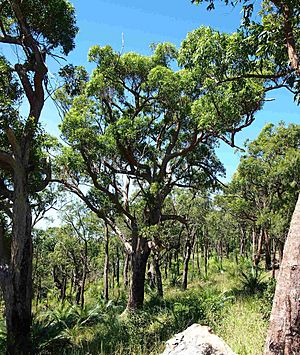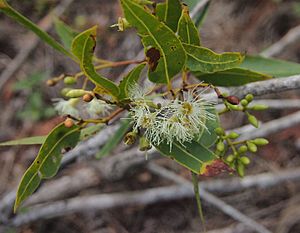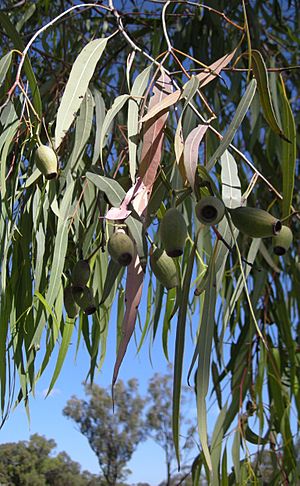Clarkson's bloodwood facts for kids
Quick facts for kids Clarkson's bloodwood |
|
|---|---|
 |
|
| Scientific classification | |
| Genus: |
Corymbia
|
| Species: |
clarksoniana
|
| Synonyms | |
|
|
The Corymbia clarksoniana, often called Clarkson's bloodwood or the grey bloodwood, is a medium-sized tree. It grows naturally in Queensland and northern New South Wales, Australia. This tree has rough, greyish-brown bark that looks like a checkerboard. Its leaves are shiny green and shaped like a spear. The flowers are white and grow in groups of seven. After flowering, it produces fruit shaped like an urn or barrel.
Contents
What Does Clarkson's Bloodwood Look Like?
This tree usually grows up to 20 m (66 ft) tall. It has a special kind of bark that stays on the tree. This bark is reddish-brown to grey-brown and looks like a puzzle or tessellation.
Leaves, Flowers, and Fruit
The adult leaves are a dull grey-green color. They are long and narrow, about 12 to 20 cm (4.7 to 7.9 in) long and 14 to 35 mm (0.55 to 1.38 in) wide. The leaves are paler on their underside.
The white flowers grow in groups of seven. You can often see them between March and August, but sometimes as early as January.
After the flowers, the tree grows fruit. These fruits are shaped like an urn or a barrel. They are about 1.2 to 2.5 cm (0.47 to 0.98 in) long and 0.9 to 1.6 cm (0.35 to 0.63 in) wide. Inside the fruit are reddish-brown seeds. Each seed has a small wing on one end.
How Was Clarkson's Bloodwood Named?
This tree was first described by two botanists, Denis Carr and Stella Carr, in 1987. They named it Eucalyptus clarksoniana in their book.
Changing the Name
Later, in 1995, other botanists named Ken Hill and Lawrie Johnson reclassified it. They moved it to a different group of trees, calling it Corymbia clarksoniana.
Who is John Richard Clarkson?
The tree's name, clarksoniana, honors a person named John Richard Clarkson. He was born in 1950 and worked at the Queensland Herbarium. He is known for collecting many plant samples, including new species, for science.
Where Does Clarkson's Bloodwood Grow?
Clarkson's bloodwood is found only in eastern Queensland and the very northern parts of New South Wales. This means it is endemic to these areas.
Its Home in Nature
You can find this tree in grassy woodlands and forests. It often grows in sandy soils. Sometimes, it also grows on rocky ridges and hilltops.
Some scientists used to think there were a few different types of this tree. However, the Australian Plant Census now considers them all to be the same species.



